The eastern part of Croatia, Slavonia, is one of the country’s four major geographic regions, where I recently spent five days on a trip with thanks to the Croatian National Tourist Board. A good part of this trip was spent eating the fine food from Slavonia, and as such, it would be remiss of me not to put together a blog post on food.
Much less visited than other parts of Croatia such as Istria and Dalmatia, Slavonia seemed to me to be the most authentic Croatian region – untouched by mass tourism.
(This is precisely why it earned a spot on our new social distance ways to explore Croatia!)
Surrounded by three major rivers, the Danube, Drava, and the Sava, respectively, form the borders with Serbia, Hungary, and Bosnia-Herzegovina, Slavonia fiercely holds on to traditions and customs. As it so often does, this is noticeable in the local cuisine.
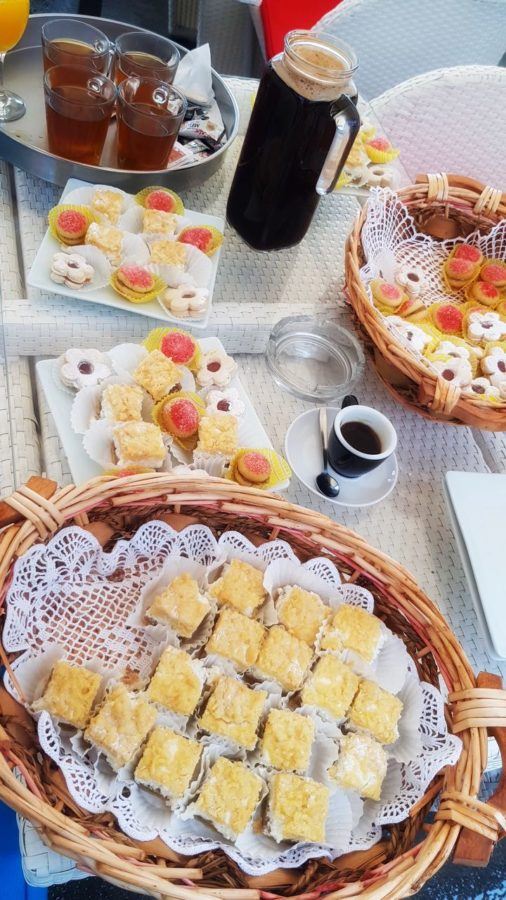
The fact that Slavonia lies between three large and meandering rivers makes Slavonia an exceptionally fertile and mostly flat region. Except for the Papuk Nature Park area, where mountains and pristine forests dominate the landscape, and the critically essential wetlands of Kopački Rit Nature Park, Slavonia is made up of expansive farmlands, vast wheat fields, orchards, and vineyards.
Slavonia is often referred to as the “breadbasket of Croatia” and, as far as cuisine goes, the most fascinating place in Croatia that I have visited yet!
Skip Ahead To My Advice Here!
The History of Slavonian Food
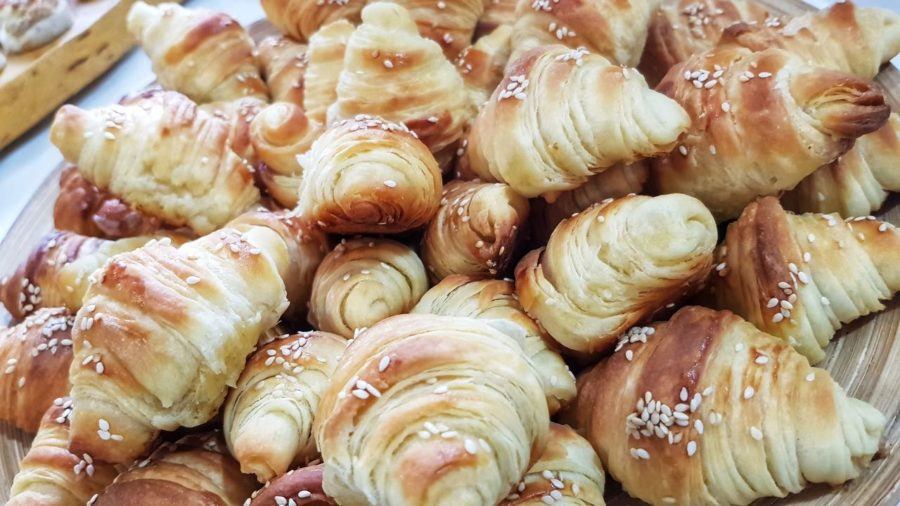
People have inhabited the fertile floodplains of Slavonia for thousands of years. This human history is visible at fascinating places such as the Vučedol archaeological site on the banks of the Danube, which is home to remnants of an ancient culture dating back the 6,000 BC.
Slavonian cultural history goes back as far as any other culture’s in Europe. This rich culture is still very much alive today. Traditional clothes are proudly worn in festivals dedicated to folklore, harvest festivals continue to be the highlight of the year, and local cuisine features an array of unique dishes.
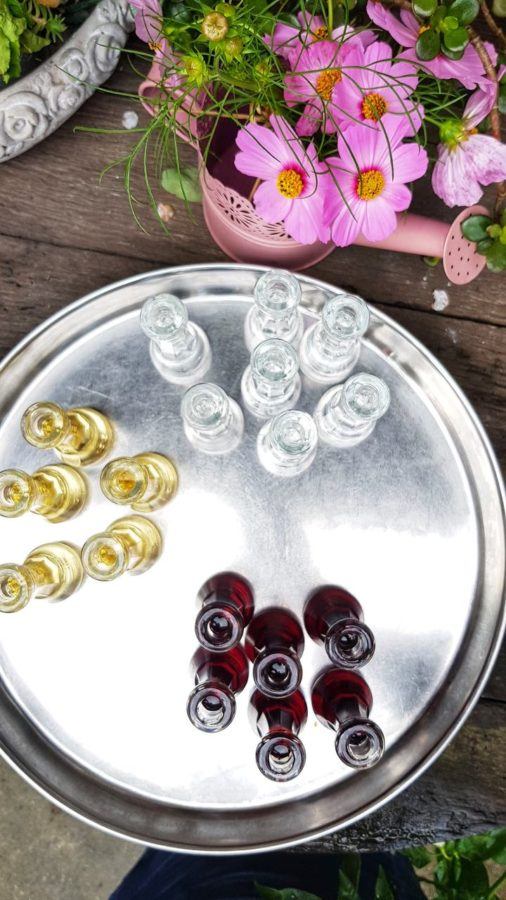
UNESCO has acknowledged the value of these surviving traditions by protecting both Slavonia’s traditional music and its folklore festivals.
Over the centuries, Slavonia has been under the influence of many different foreign rulers. Its many forts and fortified towns in the region show how strategically significant and much-contested the region was. Naturally, these foreign influences have left their mark on traditional Slavonian food as well.
Indulge In Traditional Food From Slavonia
Traditional food from Slavonia, which you can enjoy at local family restaurants, is a blend of typical local dishes and past foreign influences. The most significant foreign cultures to influence Slavonia food are those of Hungary, Austria, Turkey, and Serbia.
Staples in Slavonia cuisine are dairy products, pickled vegetables, and smoked meats. Stews are popular, while Slavonians are the biggest paprika fans in the whole of Croatia. Additionally, there are several mouthwatering traditional desserts as well.
Below, you’ll find some of the best dishes from Slavonia that I tried over my five days. If there are some I should try on my next visit (and there will be one!), please let me know.
Kulen And Kulenova Seka
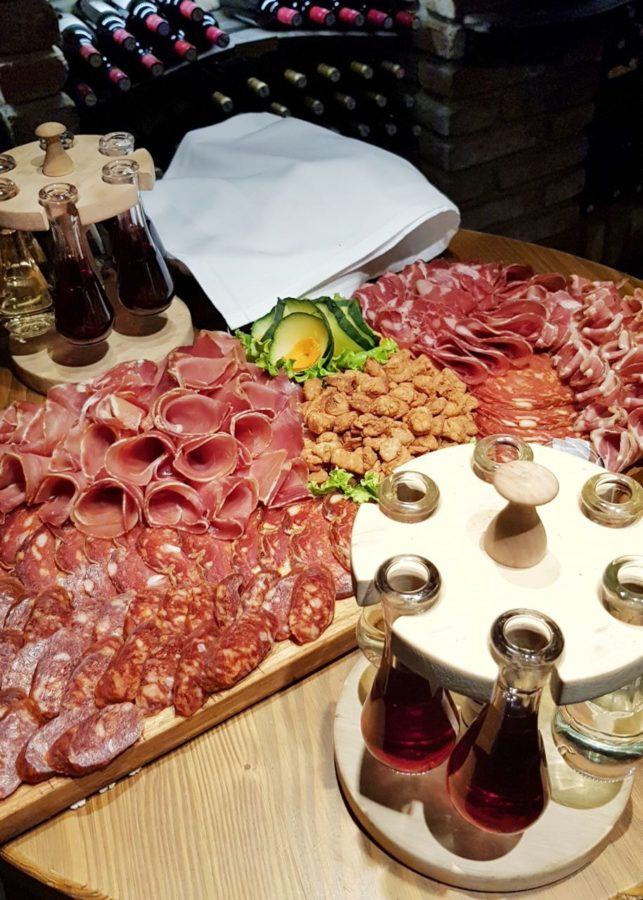
Both Kulen and kulenova Seka are sausage-type products, one of only a few indigenous Croatian products that enjoy E.U. protection.
Kulen is the most popular and valued meat product in Slavonia, if not Croatia, a pork sausage flavored with plenty of paprika. Only the best pork meat—there are age and weight guidelines for the pig—is used to make Kulen. All fat and connective tissues are removed, after which paprika, salt, and garlic are added. The Kulen-maker, a respected profession that even has grandmasters, then stuffs the mixture into a cleaned blind gut of a pig. The sausage is then salted and dried for about a month.
Kulenova Seka is a paprika-flavored and dried sausage very similar to Kulen. The only difference is that the Kulen mixture is stuffed into a smaller intestine, thereby creating a slightly smaller sausage. If you’re not a vegan or vegetarian, you simply must try this most authentic of Slavonia foods; I swear I ate like 2kg of it that week.
The best Kulen products are made using the Black Slavonian Pig. These pigs were developed from crossbreeding several pig breeds starting in the 1860s in the area around Osijek.
In the first decades of the 20th century, this breed rapidly expanded throughout eastern Slavonia, up until World War II. The breed is a meaty, high-fat pig with a solid structure, black in color, and very resilient. Now, these pigs are getting rarer; it is said that only a few hundred pigs remain due to the introduction of new, more productive crossbreed pigs that are better adapted to industrial-style farming.
Čvarci
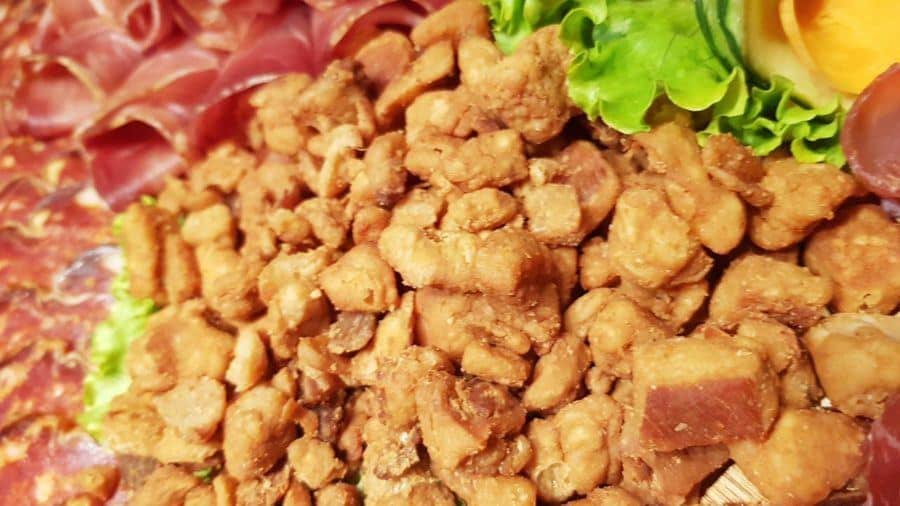
Often served along with Kulen and various cheeses on a platter, čvarci are known as pork rinds in English. Essentially cvarci is the skin of a pig – it may not sound appealing, but these fried or roasted snacks are like crisps. And, just like crisps, I found them highly addictive!
Fiš Paprikaš
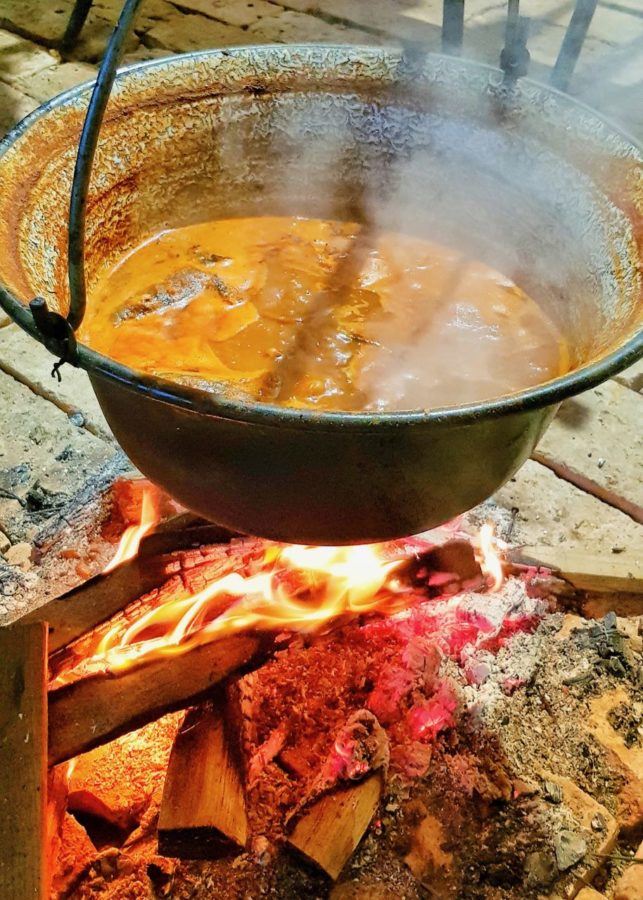
A traditional spiced freshwater fish stew, fiš paprikaš is another typical Slavonia food that shows the affinity Slavonians have for paprika.
Surrounded by three major rivers, it comes as no surprise that freshwater fish is a much-used ingredient in Slavonia cuisine. This particular stew is probably the best example of that.
You can find many different recipes for fiš paprikaš, but paprika and large chunks of fish—pike, carp, catfish, or perch—are always involved. I found myself speaking with the chefs and waiters while on my visit to Slavonia; curiosity gets the better of me, I guess. I asked the guy chopping the wood and stirring the cauldron of goodness what he put inside. He explained that he also adds white wine and hot feferoni (pickled chili) and cooks it for 1.5 hours.
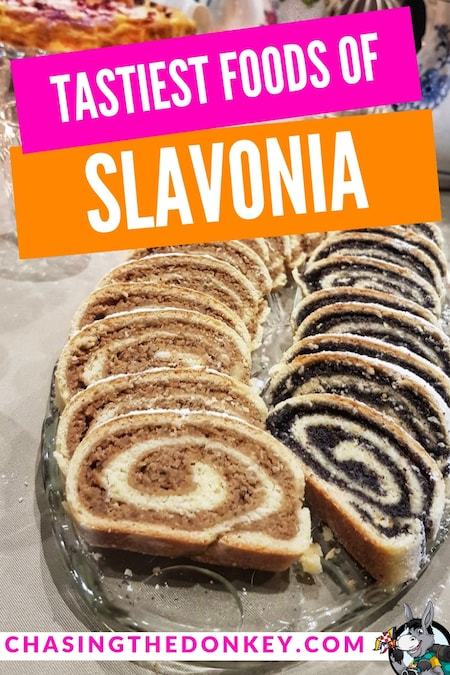
Čobanac / Perkelt
Another traditional Slavonia stew is čobanac, also known as perkelt or pörkölt. Instead of fish, this dish calls for a variety of meats. Typically, three kinds of meats are used, including beef, pork, and something else, ranging from lamb to horse meat.
This hearty and filling stew is a fantastic winter dish, traditionally prepared in a cauldron over an open fire just like the fiš paprikaš. In addition to meats, other ingredients include paprika—of course!—but also potatoes, pancetta, carrots, and a variety of herbs.
Deer Stew
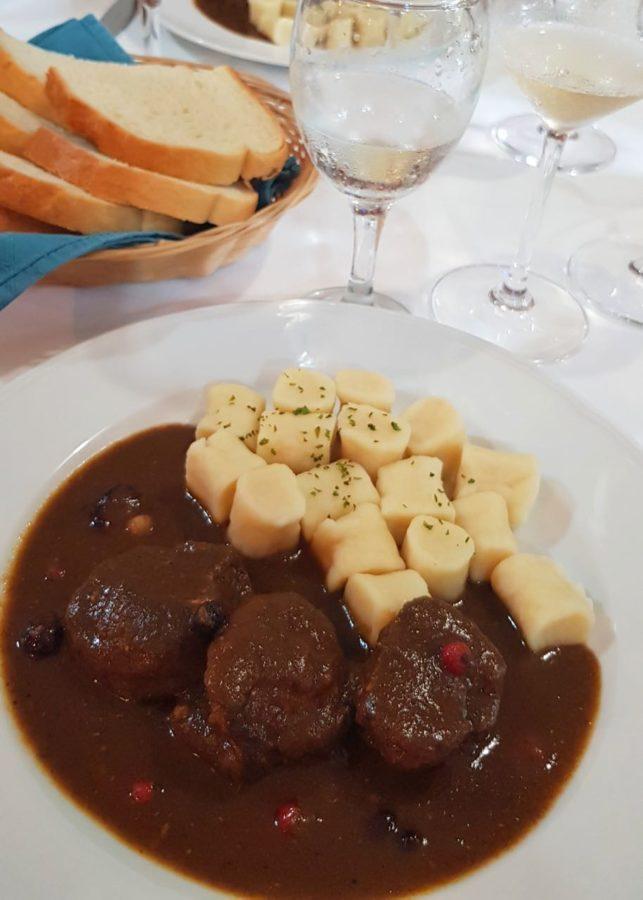
One more stew you can enjoy in Slavonia that I tried in the Virovitca area was deer stew. I knew as soon as I tasted it that it had that ‘game’ flavor. People at my table said it was a pig, but there was no way – not with such an intense flavor.
Of course, if you do not like that ‘gamey’ flavor, you should avoid it, but it is often served with gnocchi, which is just perfect for soaking up that brown sauce.
Vinogradarski Ćevap
A typical meat dish across the Balkans with origins traceable to the Ottoman period, vinogradarski ćevap is a type of minced meat. It’s pork, beef, and/or lamb on a stick, grilled by turning it over a fire.
The meat is seasoned with salt, pepper, and paprika. You can think of this as a skinless sausage. When the meat is grilled, slices are cut off and served on flatbread, typically with sour cream, chopped onions, and other ingredients.
Punjene Paprike
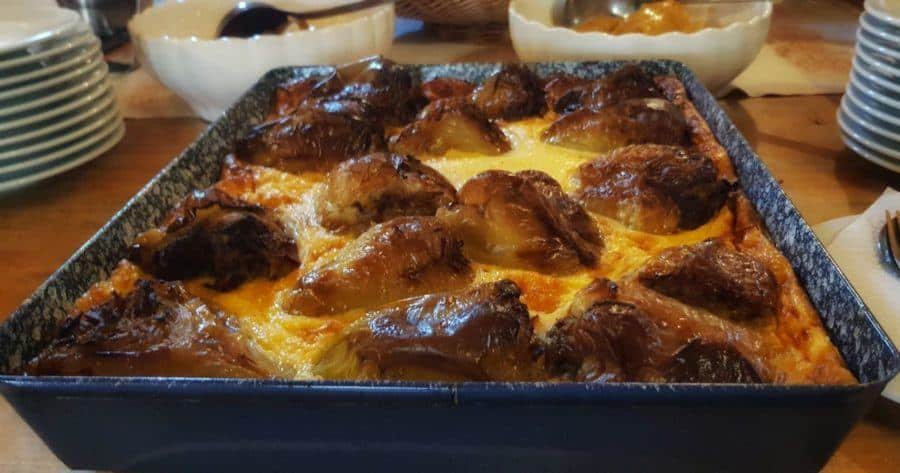
Another super-popular Slavonian food is punjene paprike. And you guessed it, one of its main ingredients is paprika. This is a pepper (aka bell pepper or capsicum) stuffed with a mixture of minced beef, ground paprika, uncooked rice, eggs, garlic, and other herbs. The peppers are then cooked in tomato paste and homemade stock in a saucepan.
I did on this trip to Slavonia, eat a variety that was baked, and not cooked on the cooktop like I have been taught to make them – and I have to say I really enjoyed it and, so now I am on the lookout for a recipe on how to make them using this method.
Šaran U Rašljama
Carp cooked on a wooden fork/stick on an open fire. Simple and tasty is šaran u rašljama! Each carp weighs about 1.5kg to 2kg, salt, and red ground sweet paprika, and hot paprika are added, and then it’s cooked for about 2 hours.
I tried my very best to speak with the chef (who spoke no English), and as I understood, you turn them just once, about halfway. They take two hours to cook thoroughly, no more, or they become dry.
The fire must be made using wood to achieve the desirable smokey flavor.
He also told me that there is no garlic or oil added, which was weird to me – as they are the main two ingredients for fish in Dalmatia, where I live.
Slavonski Med (Slavonian Honey)
Who does not love honey? Med is the Croatian word for honey, and no honey tastes better than that from Slavonia. Slavonski med is one of several Croatian products like Kulen to have received the E.U. geographical origin label. This label helps protect product names from misuse and imitation.
Native grey honeybees produce Slavonski med, and you can find some of the best honey in the Virovitica-Podravina county – this county claims to be the ‘sweetest county.’
I tried some locally made honey that was given to me as a gift on the trip – and let’s just say my toast has never tasted so good each morning since I came back. Wink.
Grilled Drava Fish
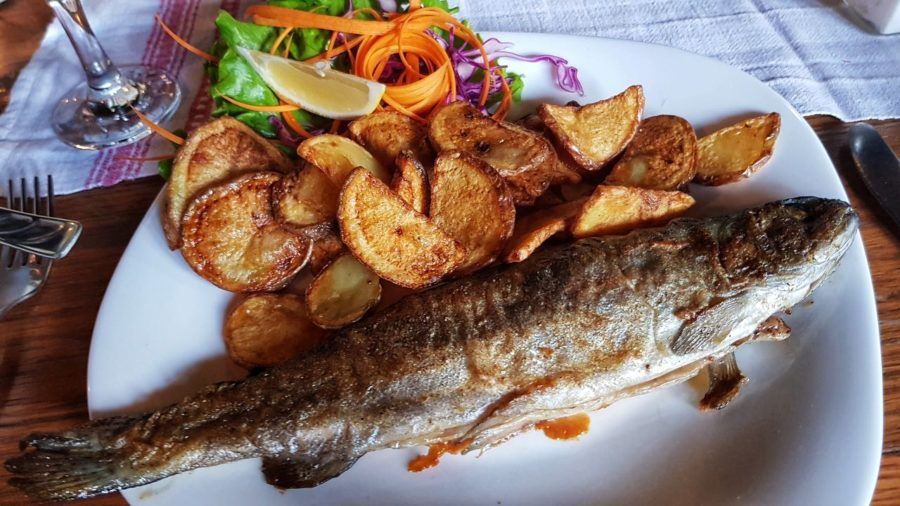
Grilled or fried just like any fish you may find across the world, in Slavonia, you’ll be served freshly caught river fish – ours was from the Drava river. Served with various salads or fried potatoes, if you like fish (like me!), you will not be disappointed.
Soups
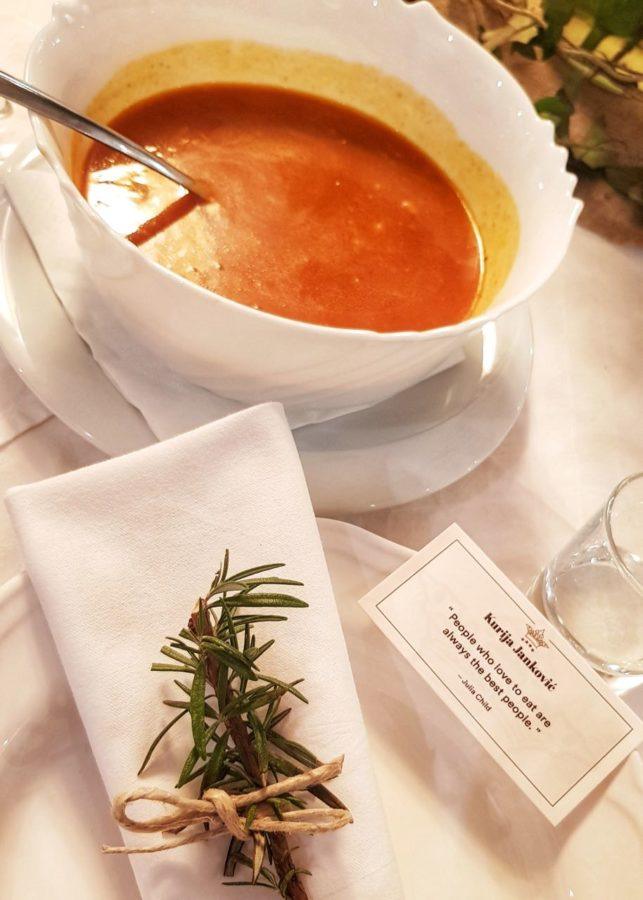
It may sound odd, suggesting soups; I mean, you can, after all, eat a soup any place. But, with so much fresh produce, Slavonia is the perfect place to try a few soups. The ones I enjoyed best were:
- Slavonian Podolian (beef) soup – best with tarana (see below)
- Mushroom soup – this was made using fresh, locally picked mushrooms
- Tomato soup – no tinned soup here, just fresh tomato soup
- Chicken soup – find one with the liver dumplings for something a little different
- Pumpkin soup
- Pheasant soup
Tarana
https://www.instagram.com/p/BeAVk1GBwKm/?utm_source=ig_web_button_share_sheet
Pasta pieces for soup. These little odd-shaped pieces sink to the bottom of the soup; the texture is dense but not too thick. They make it by creating a ball of dough and then grate it into small pieces – hence the irregular shapes.
I enjoyed this and found a recipe from a Slavonian food blogger to try this for myself, as my kids do eat a lot of pasta in my homemade soups.
Poderane Gaće
Fried bread. Need I say more?
Pasta With Poppy Seeds
Let me start this off by saying that I had a conversation in Croatian with the waiter who asked me to try this from a buffet table. He spoke no English, and my Croatian is (ahem) weak, to say the least. As I understood, poppy seeds are widely used for a variety of sweet treats in Hungary, which is right across the border.
The waiter kindly explained to me that it’s a simple mixture of wide strip pasta, finely ground poppy-seeds, and sugar. I have to say it’s an unusual mixture for me – that said, I managed to eat and enjoy a small plate of them! I just have no idea what the ‘real’ Slavonian name is. So, if you know, please let me know in the comments.
Tačkrle
Imagine a fresh pasta dish like ravioli, but instead of cheese or mushroom filling, the filling is even better… it’s a sweet homemade jam or a savory mixture of veggies and meats.
Slavonian tačkrle (or taške) comes in lots of varieties. Still, a popular one is a potato-based dough filled with fruit jam, and I enjoyed them even better than the Italian-style ravioli. I will always gravitate to on the menu.
So Many Cakes & Slices
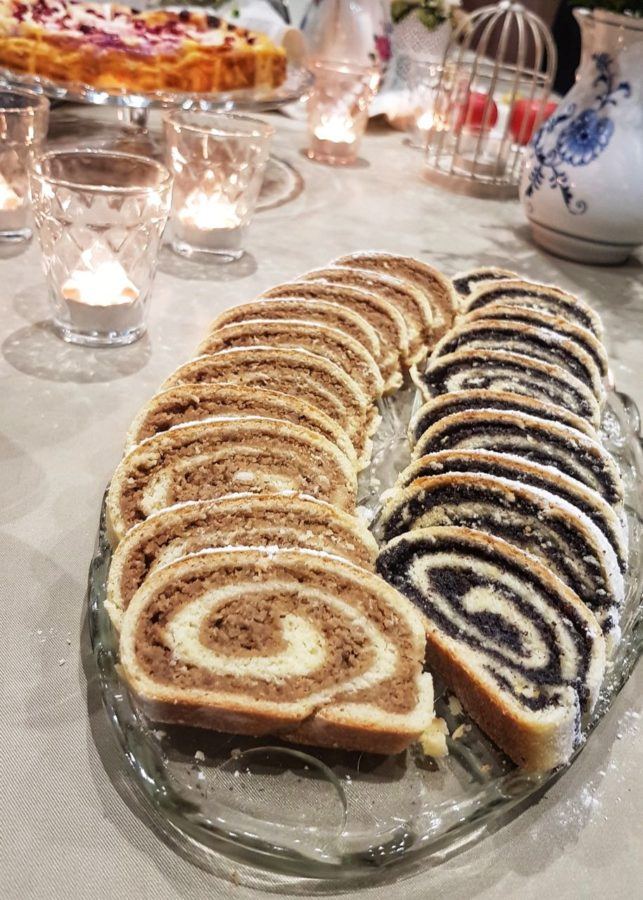
There were so many sweet baked goods on my trip that I lost track. Never fear; whichever you choose off the menu (or which ones are handed to you) will be very palatable. Some that you should be sure to get your hands on are:
- Mađarica – Slavonians surely like their sweet treats and layered cakes. One variety of these mouthwatering treats/desserts is Mađarica is a chocolate layer cake originally from Hungary. The cake consists of about five layers of cake with an equal number of layers of vanilla-chocolate filling in between. A chocolate glaze on top completes this popular cake variety.
- Medena Pita – If you have a sweet tooth, you will definitely enjoy medena pita. This is a honey-layer cake that looks absolutely flavorful. This sweet treat consists of a few different layers. Honey forms the base of the cake layers, while other fillings are vanilla and/or chocolate powder mixture.
- Pišinger – A typical treat is pišinger, a type of layered wafer cake. To make this gratifying kind of Slavonian cookie, you spread kajmak on a wafer cake, stack it with another wafer and repeat the process until you have about five or six layers. Then, wrap the whole cake with cling film and set it aside for a few hours, after which you can cut it into rectangular pieces.
- Krofne / Krafne – Round Croatian doughnuts of sorts, krofne (or krafne) is a must-try food of the Balkans. They’re round like doughnuts as you know them, but without a hole in the middle as you might find with American or Australian style doughnuts. These Croatian doughnuts are light and airy and are traditionally filled with a yummy center of apricot jam. These days, however, krofne are also being filled with chocolate, vanilla custard, and numerous types of jams.
- Orahnjača – A popular dessert throughout the region, orahnjača is a walnut roulade that’s cut up in slices. Often served at Christmas, it’s also a common treat for special occasions. With its filling of walnuts, homemade jam, and cinnamon, it’s both a savory and sweet dish perfect for filling up that last little space in your stomach after dinner.
- Makovnjača – Similar to Orahnjača, though Makovnjača is made with delicious black poppy seeds.
Strudle
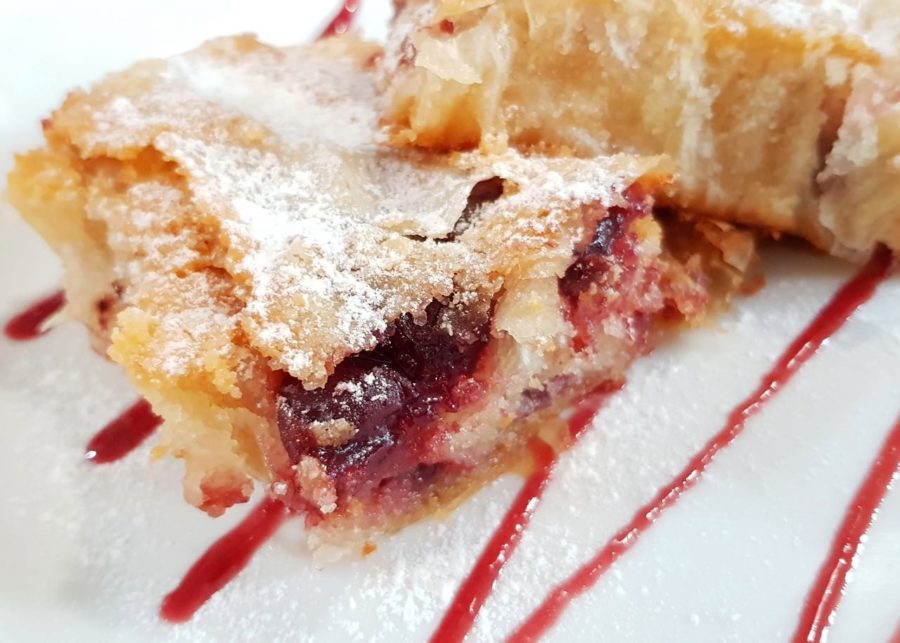
Slavonian women are astonishing bakers, and the various strudels they make are to-die-for! They come in all shapes and flavors. Cherry and walnut strudel were my favorites, but you can also find other types of strudels like:
- Cheese
- Apple
- Walnut
- Apricot
- Plum
- Poppy Seed
Rakija
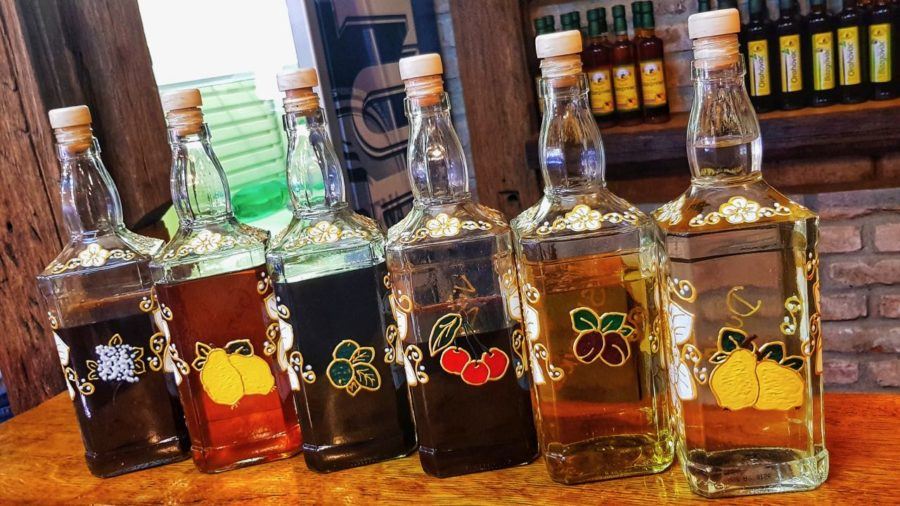
Rakija is a colorless, strong-smelling alcoholic drink (maybe like vodka or brandy to some) that is produced by the distillation of fermented fruits. It contains about 40% alcohol, though homemade rakija can contain closer to 50-60 %.
Rakija is the national drink of many Slavic nations, and I knew it was popular in Croatia, but sheesh, these Slavonians L.O.V.E. it! I was offered rakija no less than ten times on my five-day visit, maybe closer to 15! And, of course, being the good guest that I am, I obliged. Each. And. Every. Time.
Because rakija is produced by distilling fermented fruit, there are many varieties of rakija you can try. Keep a lookout for rakija produced from cherries, quince, apricots, pears, and walnuts, and my new favorite – elderflower rakija.
Brands We Use And Trust
Other Food From Slavonia
Of course, my list of suggestions is just what I enjoyed, but you can also find oh-so-much-more food in Slavonia. Keep your eyes on the menu for other delights such as:
- Ispod Peke
- Palacinke – Croatian Sweet Crepes
- Plum dumplings
- Smoked Carp
- Deer risotto
Slavonia Wine Region
In addition to food, Slavonia is also one of Croatia’s greatest wine regions. Fertile valleys combine with sun-drenched hills to create the perfect conditions for growing a variety of grapes. While wineries dot the entire region, there are two main wine-making hubs—Ilok and Kutjevo, which both have famous wineries around the world.
Premier Slavonia wines are Welschriesling and Rhine Riesling, but you can also find everything from Chardonnay and Pinot Gris to Syrah and Cabernet Sauvignon.
While I was in Slavonia, I tried a lot of wine – but I wasn’t quick enough to always see the label. That said, here are a few I did manage to remember, so you can use these as a starting base when you’re traveling the area:
- Misno Vino – Made using church laws since 1716, for example, a limit of sugar added in production. This wine is used in church. Look out for the tasty Cabernet Sauvignon and the sweet Traminac.
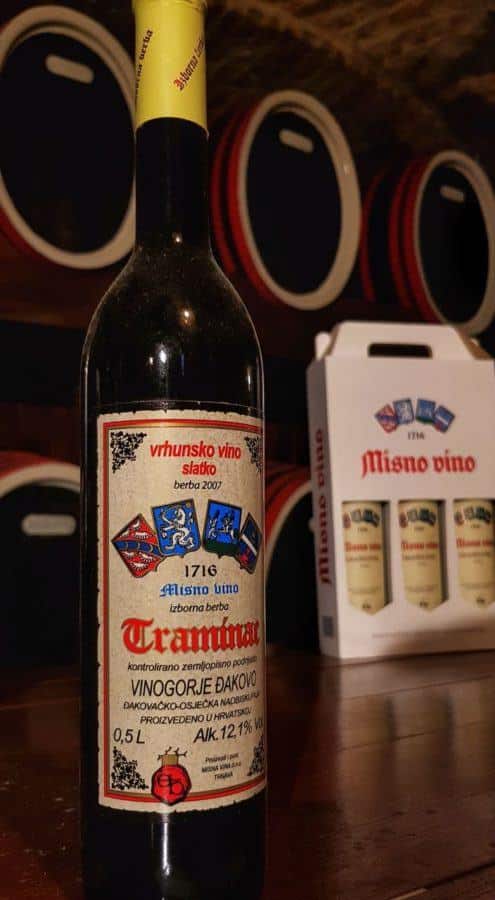
- Podrum Vineda – I enjoyed the Cabernet Sauvignon Rose
- Also, a new wine for me that I had never tried but enjoyed is the Frankovka variety. This Pannonian red variety does not receive much attention here in Croatia, and I have no clue why. It pairs perfectly with the soups and stews. Look out for the Dika Frankovka bottles.
- Kutjevo – The Grasevina from Kutjevo is the most popular, and you’ll find it all over Croatia. I took a winery tour and found the Grasevina to be a bit meh; I much preferred the Rose and the Pinot Crni.
Oh, and while Kutjevo is widely known for its top wines, I also heard that the wines have an aphrodisiac characteristic. Word on the street is that Empress Maria Theresa visited the Kutjevo winery back in the day, where she met a handsome baron named Franjo Trenk. Legend says that the two of them were in the Kutjevo cellar for seven nights. And that they left 70 marks on a cellar wall. Hmmm, what do you think? Fact or fiction?
Honestly, I have found that you can (almost) not go wrong with ordering any traditional food in Croatia – and Slavonia is no exception. Yes, the foods are vastly different from what you’ll find served on the coast, but I have to say that was a big plus for me!
Where To Eat In Slavonia
As I said, I ate a lot; here are a few of the standout places I suggest you try:
- Jankovac Mountain Lodge
- Heritage Hotel Janković
- Stari Fenjeri Požega
- Zlatni Lug
- Grgin Dol
- Kuca Dida Tunje
- Ranč Ramarin
- Camp Borovik
- Bistro Aquarius
This post is part of a series #VisitSlavonia. The Croatian National Tourist Board provided all transport, accommodation, meals, and guides, but all opinions are mine. All recommendations are given wholeheartedly and without bias. 

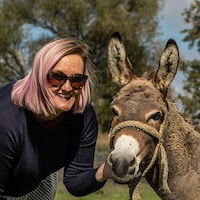
I LOVED this webpage. My grandparents were Germans from Slavonia. Do you have a chicken paprikash recipe? We do not put sour cream in ours. I have yet to find a recipe online that goes along with how my grandmother made it.
Well, excuse me, but Slavonian food has nothing to do with Serbia. Yes, we have the same dishes but only because we were all under Turks. All Balkan countries have Turkish food. Thank you and goodbye.
Well, that’s funny, as when I was there, that’s what the locals told me. I mean Turkish rule was like how many hundred years ago? Thank you and goodbye.
Awesome page! My dad and brother live in slavonia (pakrac) ,my brother has bees and has the slavonian honey, my dad makes cherry brandy and loves to make cobanac :) . im here for the recipes and love to read about you adventures, i visit 2 times a year since i live in the netherlands.